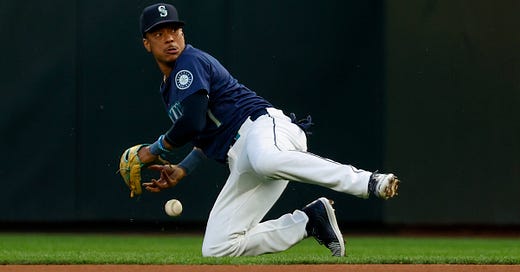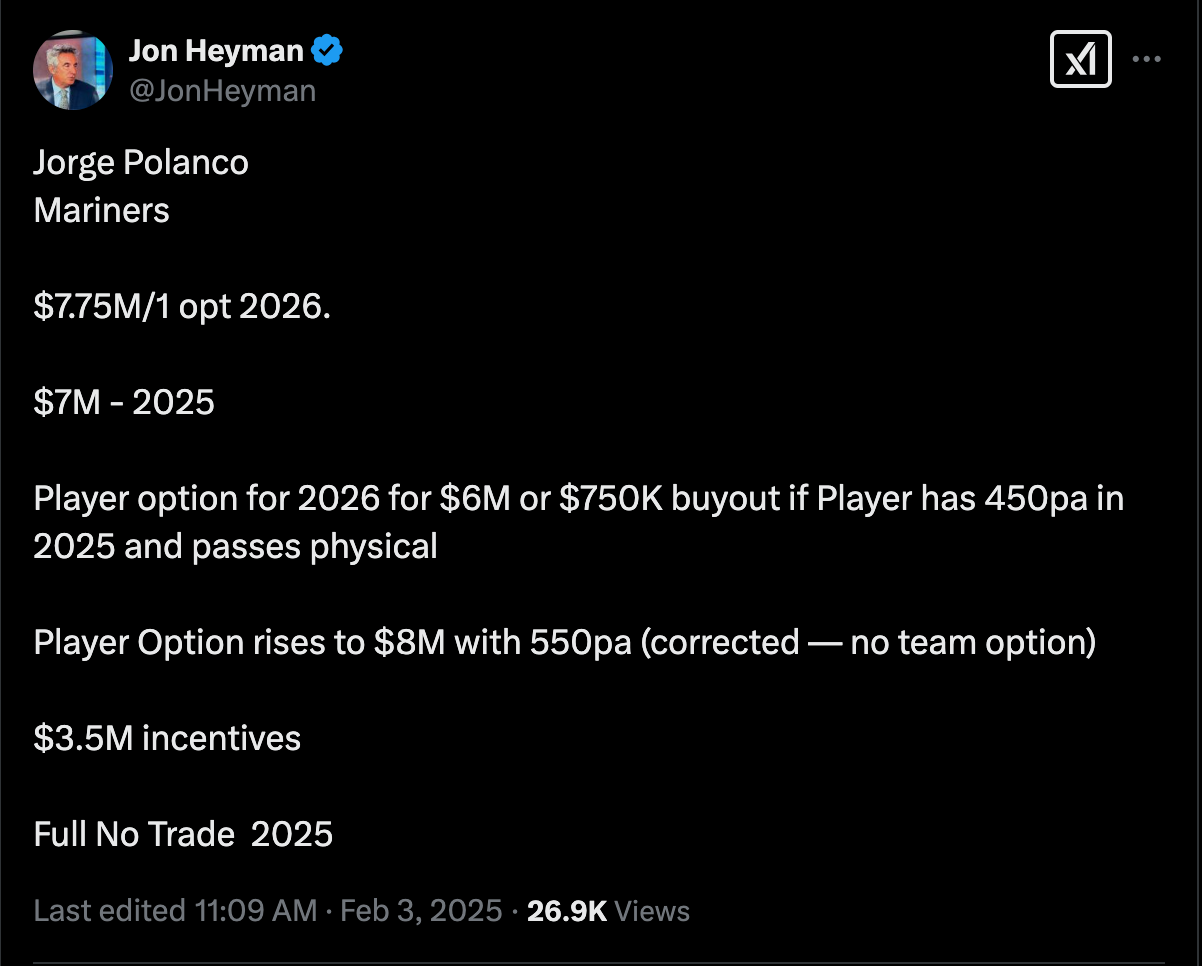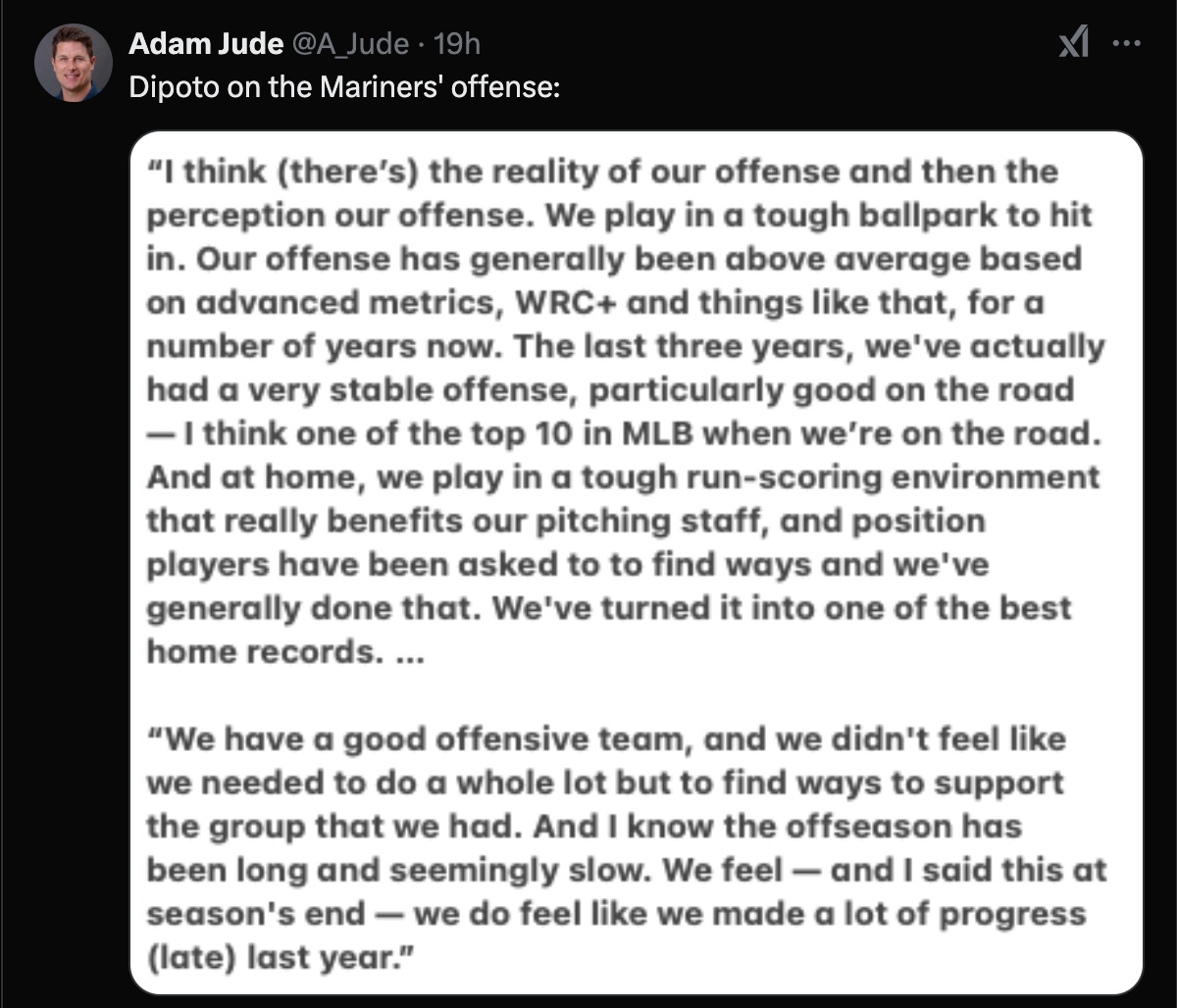The Mariners bring back Jorge Polanco
Seattle closes their unambitious offseason with an uninspiring reunion
There’s not a player I personally struggled with watching more on the 2024 Mariners than Jorge Polanco.
With that context, it should come as no surprise that Thursday’s news that the Mariners had agreed to a deal with Polanco to fill their gaping third base hole left me shocked, confused and resigned about the state of the Mariners’ offseason.
Signing Polanco effectively brings to a close an offseason of stunning and depressing inaction from the Mariners. They filled the vacated roster spots of Justin Turner, Josh Rojas and Polanco with additions of Donovan Solano, Austin Shenton and…Polanco. It’s a group of moves totally lacking in upside, the very upside a team addicted to winning barely too few games to make the playoffs should be desperately chasing.
The Mariners will pay Polanco $7 million in 2025 with up to $3.5 million in incentives and a complicated vesting option for 2026. Jon Heyman reported Monday that Polanco also has full no-trade clause for 2025. It’s an aggressive offer from a financially limited baseball team for a player whose first experience in Seattle was brutally below-average.
Hurt or injured?
There's just so much to look past to legitimately like the move, starting with believing that none of his overall numbers last year matter much because he was hurt.
Polanco posted a 92 wRC+ and 0.3 fWAR in 118 games and was the very worst defensive 2B in MLB by Outs Above Average. He was far worse hitting in Seattle than on the road, even by wRC+, which adjusts for Seattle’s league-worst park factor for hitters but still assigns Polanco an 86 at home and a 98 on the road last season.
Core to the thesis to downplay these numbers are Polanco’s injury struggles in 2024. He missed a chunk of time with a hamstring injury, but depending upon your perspective, a nagging knee injury derailed as much as the entirety of Polanco’s season. Polanco had surgery in October to repair the knee, which had apparently been bothering him for years, and his agent immediately insisted he’d be right as rain by the start of the 2025 season. Among my chief frustrations with the signing, Mariners fans now need to hope this timeline wasn’t agent-driven hopium. The Mariners taking more than 72 hours to officially announce the signing at least seemingly portends that they didn’t take anything for granted with Polanco’s pre-contract physical.
Polanco wasn’t always terrible in 2024. After he returned from his IL stint in late June he got ramped up and then hit quite well in July and for most of August. From July 9 through August 20, Polanco slashed .274/.348/.504, good for a 147 wRC+ and 1.0 fWAR despite his continued terrible defense. In a six-week window, you could see the vision of why the 2B-needy Mariners traded a once-coveted OF prospect to the Twins to acquire Polanco.
He also carries a solid but significantly checkered history of success from his time in Minnesota. He debuted in MLB at age 20, and amassed 3.0 fWAR through his age-23 season in 2017. In March 2018, Polanco was suspended 80 games for performance-enhancing drug use. In 2019, he had a brilliant offensive season for the Twins, who hit the most home runs in MLB history thanks to the juiced ball, but was a terrible defender at SS. His best year was 2021, where a move to 2B blunted the negativity of his defensive impact, and a career-high 33 homers led to a 4-WAR season.
In the two seasons following his career year, he posted 3.1 fWAR across 184 games. In that time, his archetype as a player was consistent: an above-average hitter and a poor defender and runner who struggled to stay on the field due to lower-body injuries. The Mariners traded for him a year ago with that in mind, but what they got was pretty close to the worst-case scenario. In particular, Polanco’s K%, a sterling 14-19% throughout his youth and prime, continued its mid-career spike from 21% in 2022 and 26% in 2023 to a ghastly 29% with the Mariners. His .213 batting average was a career-worst by more than 20 points, his .296 OBP was his first season under .300, and his SLG% was drastically lower than in any previous season beside the 2020 COVID year.
But to consider bringing him back as a full-time starter, the Mariners have to view Polanco’s worst season of his career as an injury-related aberration.
Some positivity?
Here’s where I’ll interject with my most optimistic take on the signing. Part of the stunning aspect of the Mariners reuniting with Polanco was that both sides wanted to reunite at all after how poorly last season went.
At the very least, the return of the offseason’s signature acquisition who then massively disappointed means the Mariners didn’t have any significant concerns about Polanco’s work ethic or clubhouse fit. As we’ve seen in the past with guys Luis Urias, Eugenio Suarez or even Jean Segura, they’re capable of making these concerns public one way or another.
In the post announcing his signing Monday, Jerry Dipoto praised Polanco’s professionalism and toughness from 2024.
Julio Rodriguez posted his excitement for Polanco’s return on Instagram after the news was announced Thursday. Retired MLB pitcher and Seattle Mariners fan Trevor May said on Foul Territory Friday that Polanco was one of his favorite teammates during the seven years they played together in Minnesota.
If Polanco was truly a beloved teammate in the Mariners clubhouse, his return carries at least some inherent positivity, as the Mariners grow into the post-Scott Servais era.
Far more questions than answers
I see an inherent contradiction in throwing out Polanco’s overall numbers but highlighting the upside he showed for roughly six weeks coupled with the good parts of his track record in Minnesota. It feels more accurate to consider what happened in 2024 with Polanco to be a realistic bad outcome for an injury-plagued, aging player who contributes negative value with speed and defense.
Polanco’s good production also doesn’t line up with the period of time when the Mariners offense turned the corner late in the year. In fact, the end of his six weeks of solid performance and the beginning of his late season swoon almost directly coincided with Dan Wilson and Edgar Martinez taking over. The so-called Edgar effect, the central element to the bull case for the Mariners offense in 2025 that was bolstered this offseason by the hire of hitting coach Kevin Seitzer, didn’t help Polanco, who was the worst Mariners regular after Edgar joined the team.
Another open question surrounds Polanco’s health: did he have a bad knee last year and for much of the two years before that that’s now all the way fixed, or does he just have bad knees in general? How much will the surgery impact Polanco’s start to the 2025 season, and is it reasonable to conclude that the injury is a thing of the past?
Those are difficult questions to answer with any sort of confidence. As noted above, the Mariners put vesting player options in Polanco’s contract at both 450 and 550 plate appearances, numbers he didn’t hit in 2022 or 2023. He did clear the first of those thresholds in 2024 despite his poor play, and Fangraphs’ projection systems think he’ll be in the neighborhood of one or both thresholds in 2025.
All that aside, the Mariners decided one of the worst defensive infielders of the last decade in MLB should fill their 3B void in 2025. Seattle Sports’ Shannon Drayer, whose insight usually aligns with the organization, articulated Thursday why Polanco could be better served at 3B than 2B.
There’s at least some reasonable thought process there, considering Polanco’s biggest issue at 2B was his league-worst range. Of course, in his brief MLB track record at 3B, he hasn’t been a good defender there either. The Mariners do have best-in-class infield coach Perry Hill to monitor Polanco’s hot corner transition.
But the Mariners have had Hill for years, including last year, when Polanco was the worst 2B in MLB. To think Polanco will hold up at 3B, you have to trick your brain into believing an increasingly complex set of scenarios that will all come true at once. He’s fully healthy suddenly, and missing much of the offseason rehabbing surgery won’t have any impact, and even though he’s still not a good athlete or defender when healthy, Perry Hill can coach him to overcome that, even though he could do nothing even remotely close to that last year. Frankly, it beggars belief.
Putting it in context
No offseason in the Dipoto era has seen fewer consequential moves than this one.
Perhaps the team’s uncharacteristic inaction won’t hurt the Mariners that much. After all, the actions Dipoto and Co. HAVE taken the last two offseasons, charitably, have not helped the team improve whatsoever, and less charitably, have actively hurt the team. Take last offseason, for example. Dipoto cleared payroll flexibility to bring in five new offensive players and Gregory Santos, a flame throwing reliever. The five offensive players racked up 1.8 fWAR COMBINED, less than the individual fWAR of the only good addition last year, Luke Raley. Santos appeared in eight games and seemed to sprout a new injury issue every month.
Unfortunately for purposes of this commentary, one of those bad additions last year was Polanco himself. Running it back this year with Polanco as the signature acquisition of the offseason for the second straight year, this time with much less upside from supplemental moves and a position change that sounds challenging at best, doesn’t exactly inspire confidence.
Neither did Jerry Dipoto when he held a closed press conference on Zoom Monday to discuss Polanco and the offseason as a whole. Instead of acknowledging lackluster results at the presumed end of an offseason that started with the stated goal of upgrading nearly the entire infield, Dipoto did his very best to spin the Mariners current situation positively and project confidence in a roster with minimal changes.
To me, the delayed reunion with Polanco coupled with Dipoto’s comments Monday point to yet another instance of this front office’s inability to acknowledge its shortcomings and constant need to present every action (or inaction) as part of a grand strategy. The nadir of this mindset was the infamous 54% press conference in 2023, where Dipoto told fans he was doing them a favor just days after falling short of a return to the playoffs. It’s a continued insistence that fans and media aren’t intellectually capable of grasping Dipoto’s grand vision, and an ongoing frustration with a lack of praise and veneration for this front office’s expert execution of winning 85-90 games each season.
And from the reaction Monday, basically everyone who’s not at least tangentially on the Mariners payroll or haven’t chosen to willfully ignore Dipoto’s words are fed up with the spin. Monday didn’t bother me nearly as much as past Dipoto comments have, most likely because all of it was so eminently predictable.
The more this front office runs the exact same media playbook over and over, the more transparent the layers of BS insulating them become. Their public comments about Roki Sasaki, which for some reason became the focal point of their media strategy at the Winter Meetings in December, were nearly identical to what they said about their efforts to land Shohei Ohtani when he came over from Japan in 2017. This time, the Mariners didn’t even get a meeting. Fans can predict the spin that Dipoto will deploy to justify a second straight offseason headlined by Polanco, because he’s running an increasingly clear grift to justify his continued employment as the Mariners chief executive after nine seasons with one playoff appearance.
Maybe Polanco’s knees finally hold up this year, and he delivers the outcome the Mariners are once again seeking: something like 120 games of a 120 wRC+ and defense at 3B that doesn’t help you but doesn’t kill you either. If enough stabilizes across the rest of the roster, and the Mariners get a breakout or two, the vision of an 88-win division contender isn’t too hard to see. Heck, even the absolutely brutal offseasons before the 2023 and 2024 seasons saw those two teams show significant flashes of AL West contention.
But that’s the problem, isn’t it? The Mariners are built to continually churn out 85+-win seasons, but that doesn’t control for variance in what that outcome means. If the worst team in MLB history suddenly shows up in your league like it did in 2024, the mediocre teams in that division suddenly become more viable wild card contenders, even if their rosters are slightly worse than yours.
If anything, the Polanco reunion and an offseason of overall cautious inaction show the people in charge of the Mariners are perfectly content to continuing rolling the dice on this strategy until they eventually hit their lucky number. The fans of this baseball team have devoted decades of their lives despite less success to show for it than any other MLB franchise. They deserve more ambition, and after Monday, much more respect from those in charge.










